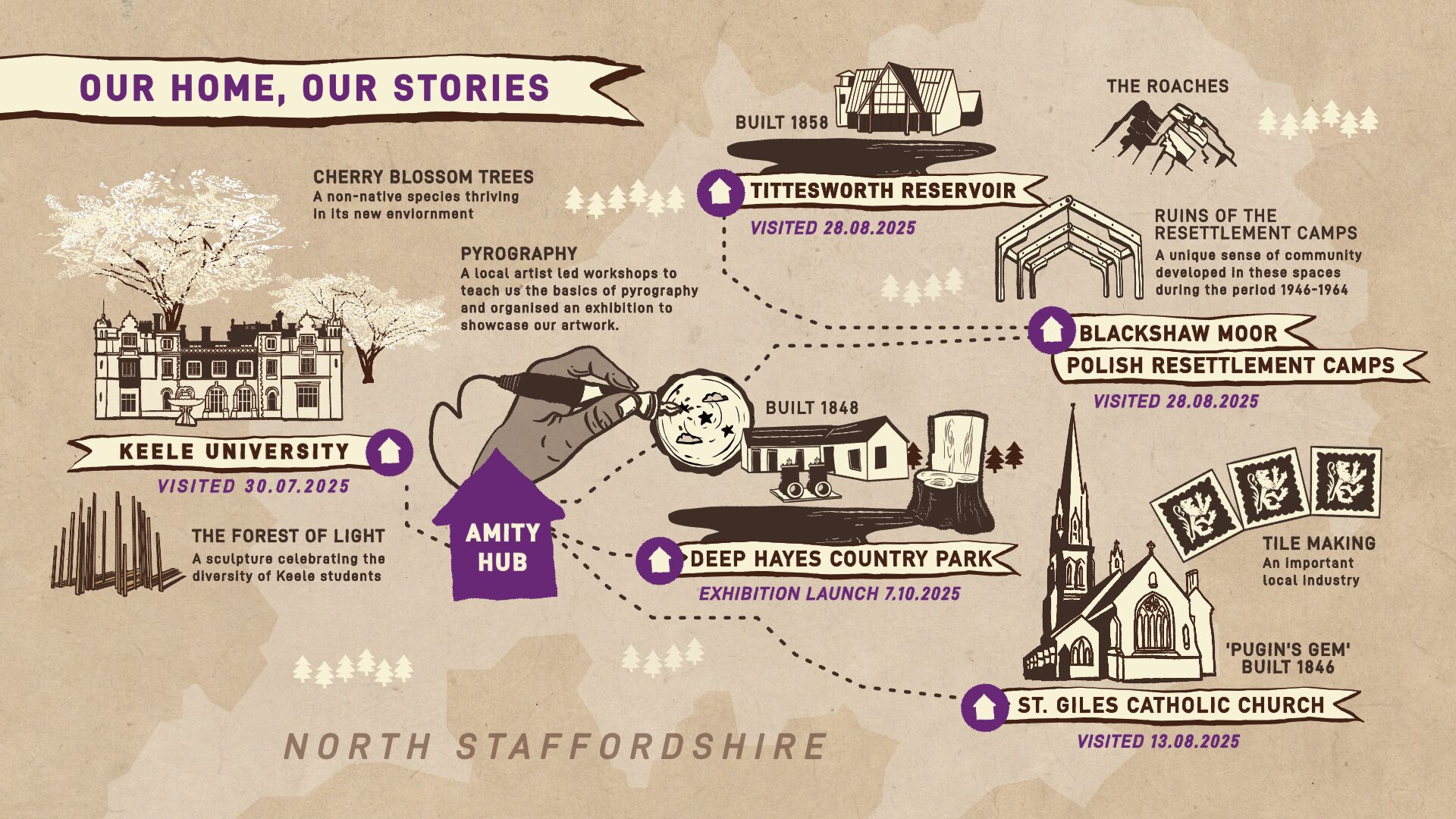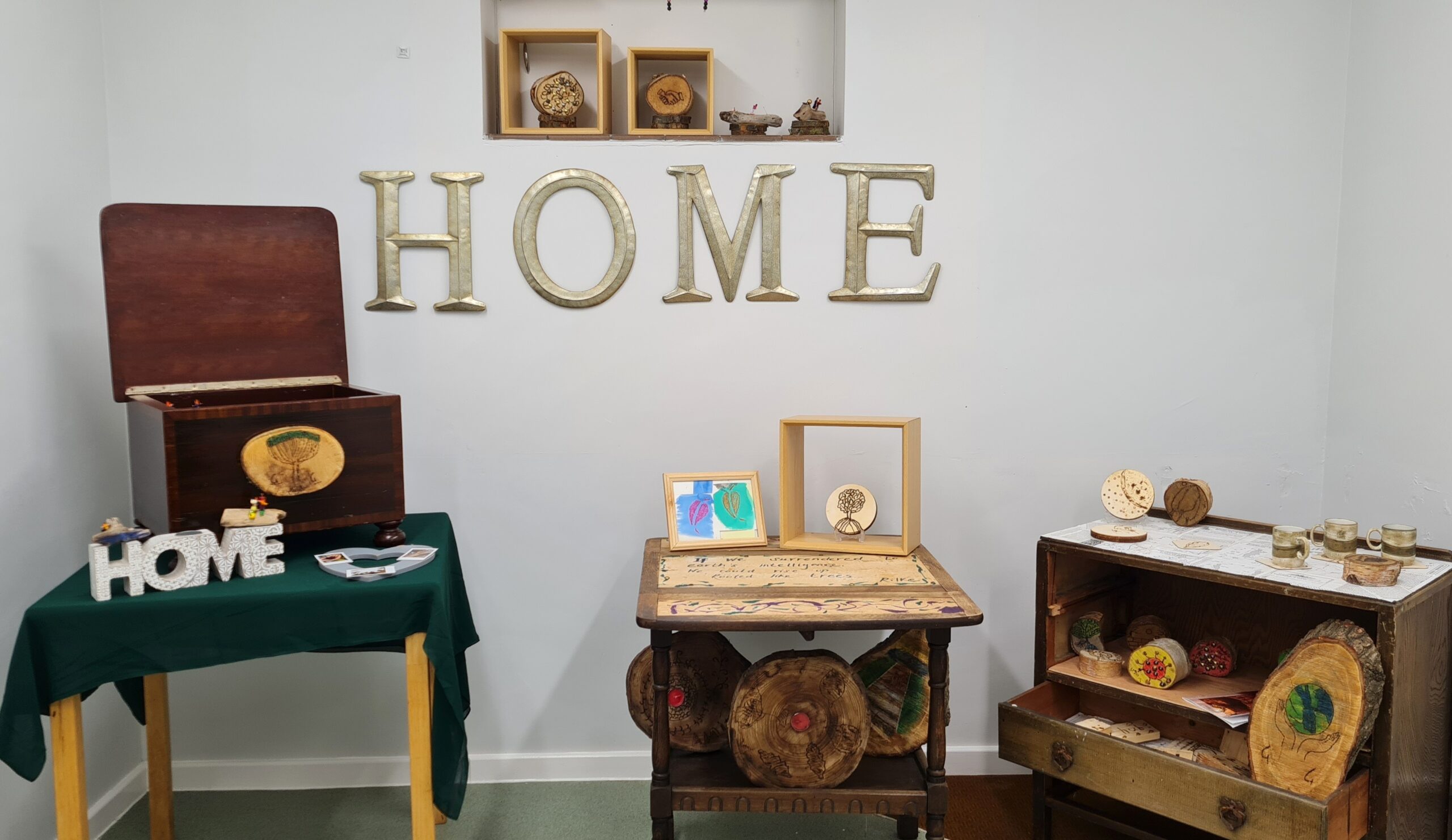what is the project all about?
“Our Home, Our Stories” is a creative project that uses the rich history of the Staffordshire Moorlands to support young people aged 16–20 who are Separated Children and Young People (CYP), also known as Unaccompanied Asylum-Seeking Children. The project helps them build a sense of connection to their new surroundings and homes by using art, history and culture. At the same time, the project highlights the strengths, resilience, and creativity of today’s Separated Children.
The project was delivered by us here at TMC in partnership with Staffordshire County Council’s Virtual School. Over a six-month period, 35 participants engaged in creative workshops inspired both by local history and by their own personal stories and connections to Staffordshire Moorlands.
Weekly sessions were facilitated by Emma Dawson Varughese, a local creative artist specialising in heritage, storytelling, and languages. She guided the young people in developing their own artwork, with a focus on pyrography and other techniques.

how did the project achieve its goals?
Weekly sessions were facilitated by Emma Dawson Varughese, a local creative artist specialising in woodwork, heritage and languages (storylogs.co.uk). She guided the young people in developing their own artwork, with a focus on pyrography and other techniques.

what activities took place during the project?
The project began at Amity Hub, where young people participated in over 15 weekly creative sessions led by Emma. The workshops introduced pyrography and associated burning techniques. Participants first practiced on scrap wood before progressing to more prepared and larger pieces for their designs. Following the Amity Hub sessions, Emma led five workshops at Deep Hayes Country Park near Cheddleton. This park was selected for its historical significance, particularly the Deep Hayes Reservoir, built in 1848 by the Staffordshire Potteries Waterworks Company and managed by one of the partners on the project.
To deepen the young people’s connection to the Staffordshire Moorlands and its historical environment, several site visits were organised throughout the six-month project. These visits aimed to help the participants feel more rooted in the region by recognising and celebrating the stories of other communities and expressions of local heritage which are depicted in this map that has been created for the Our Home Our Stories project.

Our first visit was to Keele University just outside the Staffordshire Moorlands. The tour began with the Forest of Light art installation, which reflects the diverse backgrounds of Keele students. This was followed by a visit to the cherry blossom tree collection, symbolising how non-native species can thrive in new environments.
Back in the Staffordshire Moorlands, we visited St. Giles Catholic Church in Cheadle, known also as “Pugin’s Gem”. This church was designed by Augustus Welby Pugin, a key figure in the Gothic Revival movement. The group was given a tour by Louie Young through which the young people learnt about the interconnected heritages of the Staffordshire Moorlands and the city of Stoke-on-Trent. We spent time looking at the ornate tiles found in the church and this conversation inspired the young people to create art pieces that reflected the patterns and symbolism of the tiles.

The Staffordshire Moorlands has an important history in the resettling of Polish soldiers and their families at the end of the second Worls War through to 1964 at Blackshaw Moor camp, just outside of Leek. A visit to the former resettlement camp was arranged for the young people and they met men and women now in their 60s who had grown up there. The visit included exploring the ruins of former homes and talking about the resilience, cultural traditions, and strong sense of community that developed among the residents and how they assimilated into Staffordshire Moorlands life.
After the Blackshaw Moor visit, the group stopped at Tittesworth Water Visitor Centre for lunch. The nearby reservoir, originally constructed in 1858, now supplies water to homes and businesses across the Staffordshire Moorlands, Stoke-on-Trent, and Leek.
what was the final result of the project?
To conclude the project journey, an exhibition was organised from the 7th to the 9th of October 2025 at Deep Hayes Country Park and visited by 49 people. A series of ten pyrography artworks made on sections of tree logs was displayed along one of the park’s pathways, some pieces were hung in trees, others mounted on posts. The collection will soon travel to libraries across Staffordshire, so even more people can experience these amazing stories.

A chair sculpted from a one of the park’s trees was created as a place marker by Deep Hayes Country Park Rangers and is now located next to the old visitors’ centre. It was crafted from one of the park’s own trees, and it stands as a symbol of growth, resilience, and connection.
“It was good to see all the “artwork” especially the outdoor exhibition, which reflects what is going on in the minds of these young people and what they aspire to. Thank you for making this exhibition available very thoughtful and provoking. I hope they realise their dreams and thoughts”, one of the visitors commented on the exhibition.
This short video gives you a glimpse into Our Home Our Stories: the project, the people, and the powerful artwork created along the way.
To hear more about the project from the point of view of the young people check out this video with more details about the 10 pieces displayed at the exhibition…



